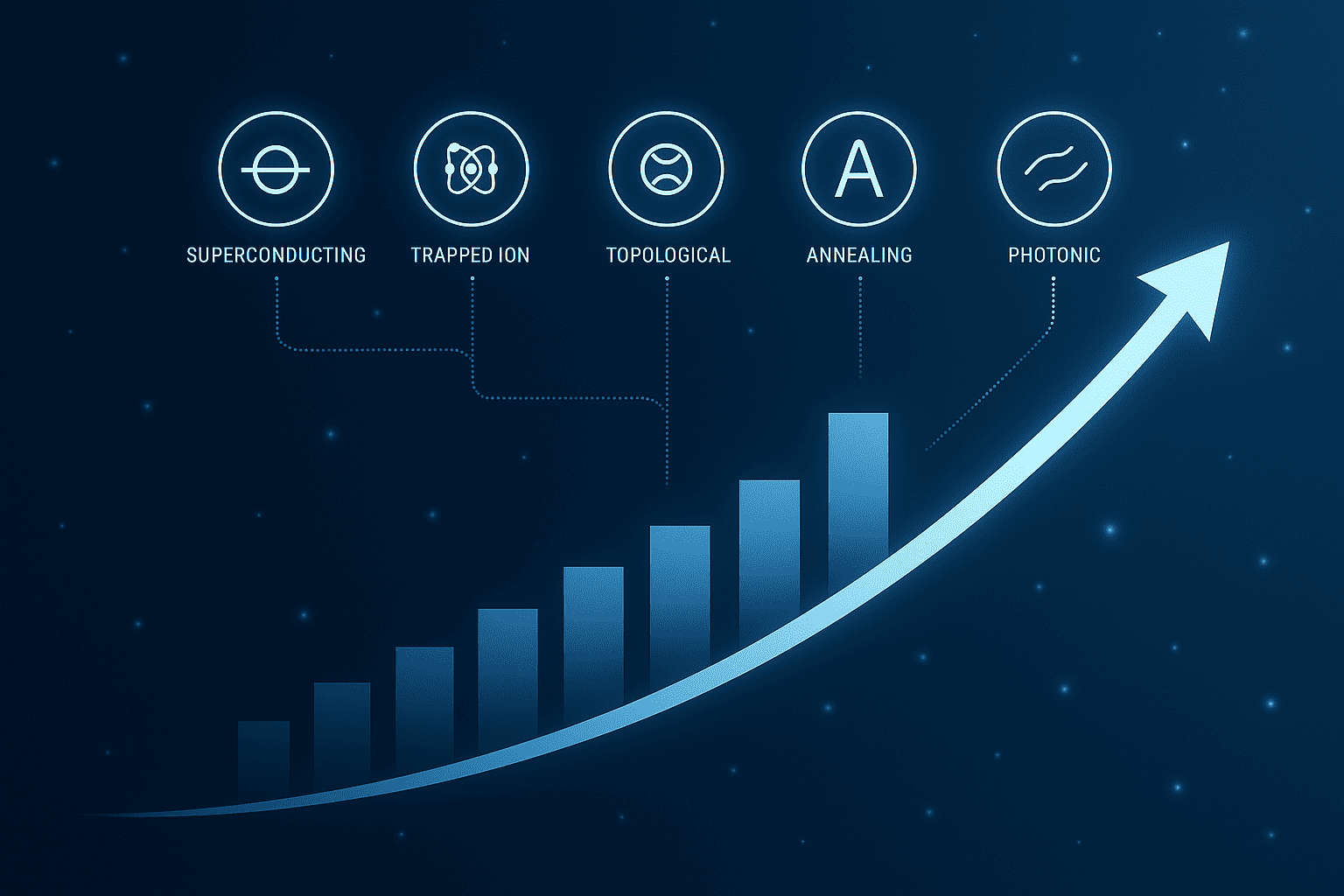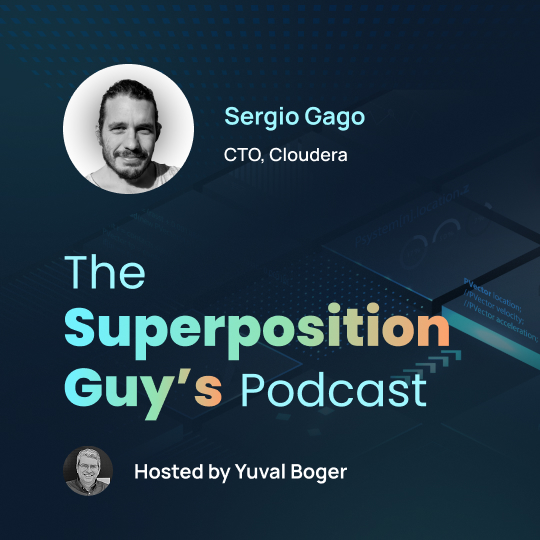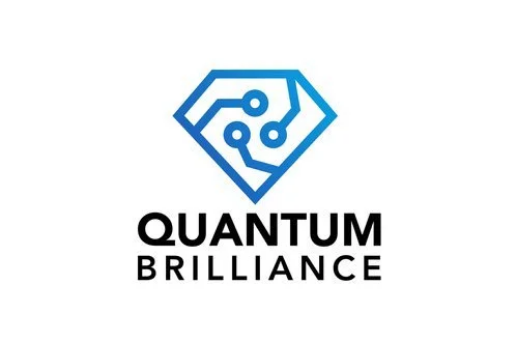Insider Brief
- Major quantum computing companies, including IBM, Google, Microsoft, Rigetti, D-Wave, IonQ, Quantinuum, Intel, and Amazon, have outlined roadmaps with varying approaches and timelines to achieving quantum advantage.
- These roadmaps focus on different quantum architectures, such as superconducting qubits, trapped ions, topological qubits, and quantum annealing, with milestones ranging from near-term practical applications to long-term fault-tolerant computing.
- While companies predict transformative impacts in optimization, AI, and scientific simulations, significant challenges remain, including qubit stability, error correction, scalability, and integration with classical computing.
Quantum computing, a field leveraging quantum mechanics to perform computations beyond classical capabilities, is witnessing rapid advance toward commercial and research uses. As of May 23, 2025, major players like IBM, Google, Microsoft, Rigetti Computing, D-Wave, IonQ, Quantinuum, Intel, Pasqal and Amazon are shaping the future with detailed roadmaps and predictions from their experts, CEOs, and former CEOs. This report, based on information from the companies and The Quantum Insider’s Intelligence Platform, delves into their strategies, timelines, and the broader implications, drawing from recent announcements and industry insights.
This is not an exhaustive list of the quantum computing companies that have published quantum roadmaps, nor is it a list of all the companies that are busy working toward quantum advantage, but just haven’t published a map yet. However, the list should give the reader some sense of the ambition — and the challenges — of creating quantum computers that can provide the computational power for some of the world’s biggest problems.
Theoretical Framework: Quantum Computing Roadmaps
The roadmaps of these companies outline their paths to achieving quantum advantage, fault-tolerant computing, and practical applications. According to TQI’s Intelligence Platform, they vary by technology — superconducting qubits, trapped ions, topological qubits, and quantum annealing — each with unique challenges and milestones. Predictions from leaders provide insights into the field’s trajectory, reflecting both optimism and realism given the complexity of scaling quantum systems.

Company Roadmaps and Timelines
IBM
- Roadmap Details: IBM’s roadmap, updated through 2033, targets a quantum-centric supercomputer by 2025 with over 4,000 qubits, focusing on improving circuit quality to run 5,000 gates with parametric circuits (IBM Quantum Roadmap). They aim for utility-scale workloads, leveraging modular architectures like the IBM Quantum System Two, supporting up to 16,632 qubits.
- Key Milestones: Demonstrated progress with the Heron processor and plans for scaling beyond 2025, emphasizing quantum error correction and middleware automation.
- Expert Predictions: CEO Arvind Krishna, in recent statements, predicts quantum computing will be a key differentiator for businesses, enabling new algorithms for optimization and simulation. Researchers at IBM see near-term advantages in chemistry and materials science.
- Roadmap Details: Google’s roadmap, outlined in 2020, aims for a useful, error-corrected quantum computer by 2029, building on their 2019 quantum supremacy with the 53-qubit Sycamore processor (Google Quantum AI Roadmap). They focus on logical qubits and scaling, with recent updates on the Willow chip.
- Key Milestones: Achieved Milestone 2 with a logical qubit prototype, showing error reduction by increasing physical qubits. Their Santa Barbara campus supports this effort, with billions invested over the decade.
- Expert Predictions: CEO Sundar Pichai, in a 2021 I/O announcement, emphasized quantum computing’s role in solving global challenges like climate change and drug discovery. He pegs quantum’s arrival between five and ten years. Dr. Hartmut Neven, leading Quantum AI, is confident in reaching their 2029 goal, predicting transformative impacts in AI and simulations.
Microsoft
- Roadmap Details: Microsoft’s roadmap, detailed on their quantum site, targets utility-scale quantum computing through three levels: Foundational, Resilient, and Scale, with a focus on topological qubits (Microsoft Quantum Roadmap). They introduced the Majorana 1 processor in February 2025, designed to scale to a million qubits, leveraging hardware-protected qubits. Microsoft is also tied into other companies, such as Atom Computing and Quantinuum, through research partnerships.
- Key Milestones: Achieved a breakthrough in May 2023 with Majorana zero modes, published in Nature, and plan to build a fault-tolerant prototype in years, not decades, as part of DARPA’s US2QC program.
- Expert Predictions: CEO Satya Nadella sees quantum computing as a fundamental shift, predicting it will unlock new scientific discoveries. Professor Chris Heunen from Edinburgh, commenting on Microsoft’s roadmap, finds it credible, expecting progress in the next few years. Co-founder and former CEO Bill Gates sees practical uses within five years.
Rigetti Computing
- Roadmap Details: Rigetti’s roadmap, updated in Q3 2024, plans a 36-qubit system by mid-2025 and over 100 qubits by year-end, with a long-term goal of a 336-qubit Lyra system. They focus on superconducting qubits and multi-chip architectures, leveraging Alternating-Bias Assisted Annealing (ABAA) for precision.
- Key Milestones: Released the Ankaa-3 system with 84 qubits, achieving 99+% two-qubit gate fidelity by 2024. Their modular approach aims for practical applications in machine learning and optimization.
- Expert Predictions: CEO Dr. Subodh Kulkarni, in a company post, said that the company will work toward practical uses for its quantum computing system, adding: “The remarkable performance of Ankaa-3 reinforces our leadership in the superconducting quantum computing field — which we believe is the winning modality for high-performance quantum computers due to their many advantages, including fast gate speeds and well-established manufacturing processes.”
Pasqal
- Roadmap Details: Pasqal’s roadmap is structured around scaling neutral atom quantum computers to deliver practical applications for industry. The company is focused on developing commercially useful systems that integrate seamlessly into business operations. The roadmap outlines a trajectory from 100+ qubits today to 10,000 qubits by 2026, with an emphasis on scalable logical qubits and Quantum Error Correction (QEC). By 2025, Pasqal expects these hardware-accelerated algorithms to move into production environments.
- Key Milestones: Deployment of quantum processors with over 100 qubits to end users, facilitating software development and industrial use case exploration. Expected transition of hardware-accelerated algorithms into production environments is pegged in 2025. In 2026, the company is expected to introduce a 10,000-qubit system with scalable logical qubits, accelerating the path toward fault-tolerant quantum computing.
- Expert Predictions: Pasqal’s leadership emphasizes the company’s commitment to industrialization and global expansion. Co-founder Georges-Olivier Reymond stated: “Pasqal is dedicated to industrialization and international development – our team is transforming fundamental quantum research into cutting-edge industrial applications. We are expanding our manufacturing facilities worldwide and opening new offices in Saudi Arabia, South Korea, and other locations to come. Our goal is to meet the growing market demand for quantum computers and have a significant impact on the quantum computing industry.”
D-Wave
- Roadmap Details: D-Wave, a leader in quantum annealing, focuses on enhancing their Advantage2 system, which now features 4,400 qubits, with continuous improvements for AI/ML workloads, according to recently announced information D-Wave’s Qubits 2025 conference. Their roadmap emphasizes practical applications, already in use by clients like Mastercard and NTT Docomo.
- Key Milestones: Launched the Leap quantum cloud service, integrating with AI for optimization, and reported customer successes like Pattison Food Group’s 80% reduction in scheduling efforts in 2024.
- Expert Predictions: CEO Dr. Alan Baratz, in a January 2025 CNBC interview, stated that D-Wave’s technology is delivering value today, predicting growth in commercial applications.
IonQ
- Roadmap Details: IonQ’s roadmap, laid out in 2020, targets broad quantum advantage by 2025, focusing on trapped ion technology. They plan rack-mounted modular systems like Forte Enterprise for datacenters and introduce Tempo in 2025 with barium qubits.
- Key Milestones: Achieved 32-qubit systems in 2020, with plans for ~450 algorithmic qubits for climate change applications, and partnerships with AWS, Microsoft, and Google Cloud.
- Expert Predictions: Former CEO Peter Chapman, in a 2024 webinar, predicted IonQ’s technology will be pivotal for commercial quantum advantage, emphasizing algorithmic qubits over physical counts. Former CTO Jungsang Kim, in a 2022 paper, foresaw trapped ions leading in fidelity and scalability.
Quantinuum
- Roadmap Details: Quantinuum’s accelerated roadmap, unveiled in September 2024, targets universal, fault-tolerant quantum computing by 2030 with the Apollo system, currently at 56 qubits with a quantum volume over two million. They focus on trapped ion architecture and logical qubits.
- Key Milestones: Demonstrated 12 logical qubits with Microsoft in 2024, achieving “three 9’s” fidelity, and integrated with Azure Quantum Elements for scientific workflows.
- Expert Predictions: CEO Dr. Rajeeb Hazra, in a 2024 press release, is confident in achieving scientific and commercial advantages by 2030, predicting a trillion-dollar market. He added:“We are the only company with a clear and demonstrable path that leverages quantum computing to tackle large-scale scientific and commercial applications. With our proven record of driving technological advancement and the unwavering trust of our global customers and partners, we are confident that we possess the industry’s most credible roadmap toward achieving universal fully fault-tolerant quantum computing.”
Intel
- Roadmap Details: Intel’s quantum computing efforts, detailed in recent research, focus on silicon-based spin qubits, with the Tunnel Falls chip marking progress towards manufacturability. Specific timelines are less public, but they aim for scalability using CMOS techniques.
- Key Milestones: Published a 2024 Nature paper on 300-mm spin qubit wafers, demonstrating uniformity and fidelity, and made Tunnel Falls available to researchers for experiments.
- Expert Predictions: Researchers at Intel predict their CMOS approach will enable mass production, with potential for fault-tolerant systems in the long term. Former CTO Mike Mayberry, in 2019 also foresaw this convergence of quantum computing roadmaps converging at the end of the decade, saying: “We say its about ten years’ away. There are some in the industry who say quantum computing is already here. From our perspective, the point at which quantum computers are able to do things that are interesting, is about ten years’ away.”
Amazon
- Roadmap Details: Amazon, via AWS, offers Amazon Braket for managed quantum services, launched the Ocelot chip in February 2025 to reduce error correction costs by up to 90%, and supports research through the Quantum Solutions Lab and Center for Quantum Computing. No fixed timeline for a full quantum computer, focusing on cloud integration.
- Key Milestones: Introduced the Quantum Embark program in November 2024 for customer readiness, and collaborates with hardware providers like IonQ and Rigetti on Braket.
- Expert Predictions: The AWS quantum team predicts transformative impacts on cloud computing, with the Ocelot chip accelerating practical applications. John Preskill, Richard P. Feynman Professor of Theoretical Physics at Caltech, wrote about the advance on LinkedIn, saying: “Today Nature published measurement results from Ocelot, the new quantum chip created at the AWS Center for Quantum Computing at Caltech. There is still far to go, but we hope that Ocelot’s unique architecture will shorten the path to quantum utility that benefits the world.”
Oxford Ionics
- Roadmap Details: Oxford Ionics has outlined a three-phase roadmap — Foundation, Enterprise-grade, and Value at Scale — aimed at achieving scalable, fault-tolerant quantum computing with over 1 million qubits. The company uses a proprietary Electronic Qubit Control method with trapped-ion qubits, replacing lasers with electronic control to improve fidelity and manufacturability via standard semiconductor processes.
- Key Milestones: Foundation phase: 16–64 qubit systems with 99.99% fidelity, already delivered to institutions like the UK’s National Quantum Computing Centre and Germany’s Cyberagentur. Enterprise-grade: 256-qubit systems at 99.99% fidelity, targeting commercial applications such as quantum-AI integration and QEC research. Value at scale: A 10,000+ qubit device is planned for release in 2027 by replicating core system designs, enabling broad-scale applications with fewer physical qubits compared to competitors.
- Expert Predictions: Oxford Ionics CEO Dr. Chris Ballance emphasizes scalability and ultra-low error rates as key to unlocking real-world impact: “The roadmap we’ve unveiled today combines scale and fidelity, essential ingredients to moving the field beyond proof of concept demonstrations and into real-world impact. We’re excited to continue putting these devices into the hands of end users.”
Comparative Analysis: Roadmaps and Predictions
To illustrate, consider the following comparison of key milestones and predictions:
| Company | Key Milestone | Timeline | Expert Prediction |
|---|---|---|---|
| IBM | Quantum-centric supercomputer | 2025 | Business differentiation by CEO Arvind Krishna |
| Error-corrected quantum computer | 2029 | Transformative for AI, by CEO Sundar Pichai | |
| Microsoft | Million-qubit chip with topological qubits | Newly introduced | Fundamental shift, by CEO Satya Nadella |
| Rigetti | Over 100 qubits | End of 2025 | Practical by 2025, by CEO Dr. Subodh Kulkarni |
| D-Wave | Advantage2 with 7,000+ qubits | Ongoing | Delivering value today, by CEO Dr. Alan Baratz |
| IonQ | Broad quantum advantage | 2025 | Pivotal for commercial use, by Former CEO Peter Chapman |
| Pasqal | 10,000 qubits by 2026 | 2026 | Emphasis on scalable logical qubits and Quantum Error Correction (QEC) |
| Quantinuum | Fault-tolerant computing | 2030 | Trillion-dollar market, by CEO Dr. Rajeeb Hazra |
| Intel | Scalable spin qubits | Ongoing | Mass production possible, by researchers |
| Amazon | Ocelot chip for error reduction | 2025 | Transformative for cloud, by AWS team |
| Oxford Ionics | Value at Scale | 2027 | CEO Chris Ballance seeks real-world impact |
This table underscores the diversity of approaches, with timelines ranging from immediate practical applications (D-Wave) to long-term fault-tolerant systems (Quantinuum).
Criticisms and Controversies
Although companies are working hard to deliver on their roadmaps, the challenges they face are daunting. Quantum computing remains in its early stages, with significant hurdles in hardware, software, and scalability. One of the biggest issues is decoherence and error rates — qubits, the fundamental units of quantum information, are incredibly fragile and prone to losing their quantum state due to environmental interference. Maintaining stability long enough for meaningful computation remains a major obstacle.
Scalability is another challenge. While companies like IBM and Google have demonstrated quantum processors with hundreds of qubits, building large-scale machines with millions of interconnected, error-corrected qubits is still far from reality. Hardware constraints add to the difficulty—most quantum systems require extreme cooling to near absolute zero, using specialized materials and fabrication processes that are costly and difficult to scale.
On the software side, quantum algorithms and programming languages are still in their infancy. Unlike classical computing, where robust software ecosystems exist, quantum development tools remain limited. Additionally, integrating quantum systems with existing classical infrastructure presents another barrier to adoption.
Future Directions and Unexpected Insights
The roadmaps of major quantum computing companies reflect a dynamic field, with timelines from 2025 to 2030 for significant milestones. Predictions from CEOs and experts highlight optimism, tempered by challenges, promising transformative impacts across industries.
An unexpected insight is the spectrum of approaches to realizing quantum value, from practical applications to more transformational aspirations. Certain companies are already on the cusp of delivering value, contrasting with the long-term focus of other firms that are investing in research and fostering long-term partnerships to develop products and services that will require robust quantum computing performance.
This article is a snapshot in time. The quantum computing industry is moving fast and these roadmaps are changing often, so, while updates are planned, this article may not accurately reflect these new details. The Quantum Insider’s Intelligence Platform is the go-to resource to keep up with this swiftly evolving market in near real-time.
For information on how you can access The Quantum Insider’s Intelligence Platform, please click on this link.


















